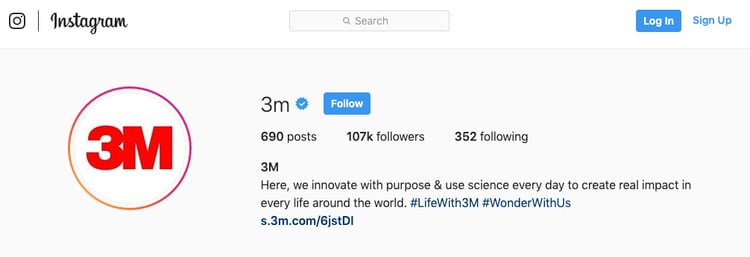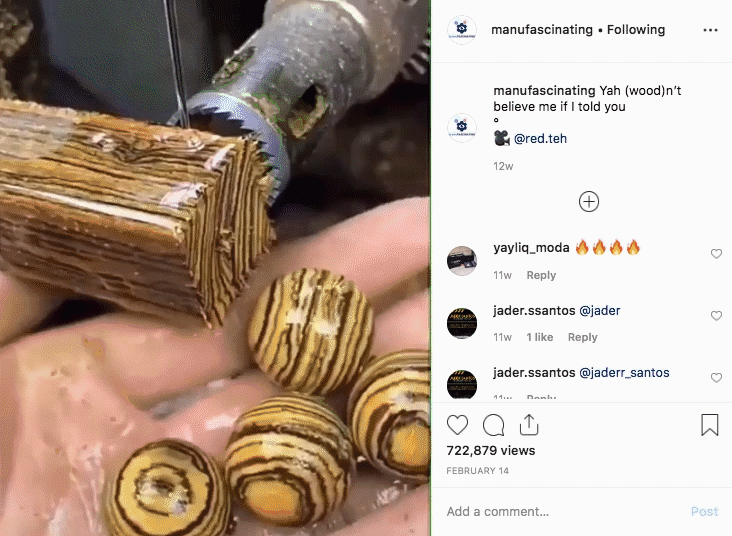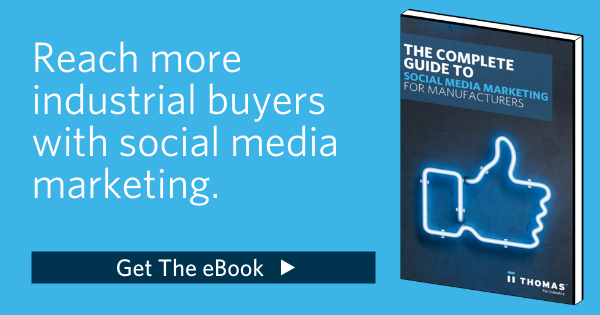The Basics Of Instagram For Manufacturers
Kristin Manganello June 3, 2019
When it comes to content marketing, social media plays an undeniably huge role in how businesses manage their online interactions with consumers and partners. You’re likely already familiar with the “Big Three” social media channels — Facebook, LinkedIn, and Twitter.
These networks are just the tip of the digital iceberg; the social media landscape is vast and teeming with a wide variety of platforms. In order to master your social media game, it’s important to understand these networks and how they can be utilized.
One of the most popular social media networks is Instagram. Synonymous with ethereal, nostalgic filters, and heavily edited photographs, this image-based platform might not seem like an obvious choice for an industrial social media marketing strategy. However, with its high popularity and excellent engagement rate, integrating Instagram into your social media marketing strategy is definitely worth considering.
 Instagram's Popularity, And Engagement Rates
Instagram's Popularity, And Engagement Rates
Boasting 80 million users in the U.S., 600 million users a month, and 400 million users a day, Instagram is currently one of the most heavily used social media networks.
Other than Facebook, it’s the most popular social media platform across many age ranges. For example, 64% of 18-29 year olds, 40% of 30-49 year olds, and even 10% of the 65+ population use Instagram. Although it is commonly associated with the younger age groups, a whopping 32% of Instagram users are 35 or older. On top of this, Instagram is also the fastest growing social media network — 5x faster than any other platform in the U.S.
Learn More: The Ultimate List Of B2B Marketing Stats
Sure, all these statistics make great trivia fodder, but can Instagram really make a meaningful impact on your company’s marketing strategy? With the right visual content, yes Instagram can work for manufacturers. 71% of businesses in the U.S. use Instagram! Also, Instagram’s engagement rate is 10x higher than on Facebook and 84x higher than on Twitter. Combine this with Instagram’s high daily traffic, and you’ve got the building blocks for a successful social media marketing strategy.
Need more convincing? Check out one of our other blog posts, where we rounded up our favorite manufacturing B2B brands that have Instagram and other social media profiles nailed down.
Creating Your Instagram Profile
While there are potential benefits of Instagram, using an unfamiliar social media platform can be a daunting task. The mechanics themselves are easy enough to master, but there are some basic tips you should keep in mind when using Instagram.
First, choose your username carefully. Both your username and name are searchable, but your username is what will be used so other accounts can follow you.
Next, claim your business account. Once you’ve signed up, go to your profile, tap into Settings and opt to “Switch to Business Account.” Doing this will give you the ability to add details such as your address, email address, phone number, and other company information. Using a business account on Instagram also allows you to access insights, metrics, and analytics about your posts, followers, and activity.
The old saying “looks don’t matter” does not apply; visuals are a crucial element to executing a strong Instagram presence. Your profile photo should be something that your audience will recognize and on-brand, like your logo. Remember, first impressions matter so your bio profile should clear — you have very limited space to grab someone's attention.
Related: Why Your Manufacturing Brand Matters To Get Engage More Buyers
A great Instagram bio for manufacturers includes:
- What your business does
- Your contact info
- Website link
- Calls-to-action
Not sure what a call-to-action (CTA) is? It's a crucial mechanic of lead generation. For the full definition and examples of high-performing CTAs, check out 32 Industrial Lead Generation Tips, Tricks, and Ideas.
Follow The Right Manufacturing Accounts and Hashtags
Hashtags are a critical aspect of Instagram to increase your audience reach. Like Twitter, hashtags are used to group together topics, communities, searches, and trends. Instagram's search functionality is mostly built through the use of hashtags, so using the right hashtags in your Instagram captions will boost your visibility in organic searches — ultimately leading you to connect with the right industrial consumers and partners. You can even add hashtags and other people's Instagram profiles to your bio profile and they become live links. For example, check out 3M's Instagram bio snippet below. The hashtags #LifeWith3M and #WonderWithUs are clickable and lead to a separate hashtag page, which provides another way for users to stay connected.

As the Instagram community continues to expand, you can learn a lot just by following industry leaders. We also recommend following your current customers, existing contacts, and even accounts you'd like to land.
Creating Your Instagram Strategy
Instagram offers you several ways to tell your story. Unlike Twitter and LinkedIn, where all posts are structurally identical, Instagram allows you to post in different formats. You can post a single photo, a longer video, or even a carousel post, which is a collection of multiple photos and videos compiled into one post.
It can be tempting to just dive in and simply post any random photos from your shop, but you need to make sure each post ties back to your marketing goals and objectives. Smart manufacturers use social media marketing to:
- Drive traffic to their website
- Establish stronger connections with their network
- Build brand awareness
- Increase leads
At Thomas, we found the most success on Instagram by creating an unbranded account (@manufascinating) that publishes great content within industry. After we earned a decent following of more than 24k followers, we began trickling in Thomas branded content.

What this all simply means is that you need to create a strategy that includes what type of content you'll be posting, when you'll be posting, how to track your efforts, and more. There are more than 8 million business profiles on Instagram, so to ensure your manufacturing Instagram profile stands out, research your audience and competitors. Find out what they're sharing on their profiles, what gets the least likes, what hashtags are they using, tone of the captions, etc.
For more components of a basic social media strategy, download our eBook, The Complete Guide To Social Media Marketing For Manufacturers.
We understand Instagram can be tricky in the B2B space, but the key to success we learned was posting engaging unique content — regularly. And it's important to have all your content aligned — that means your website, emails, social media accounts, etc. should have the same messaging so your audience has a clear understanding of your brand. Social media should not be done in a silo.
Learn More: 9 Email Marketing Types That Help Get You New Business
Remember, Instagram is a visual medium so be consistent with the quality and style of the images and videos you share. Luckily, there are tons of tools dedicated to photography and photo editing to help you build or refine your visual skills. Here at Thomas, we love using Canva to add more visual appeal to our social media posts and videos. Canva is the perfect creative tool for beginners — check out 26 Must-Have Digital Marketing Apps And Tools.

Learn More About Engaging Effectively On Social Media
Whether you're an Instagram newbie or you’re a seasoned social media rock star, it can be difficult to stay ahead of the current industrial marketing trends — they change so often. There are also so many other content marketing channels to reach your customers on, that it can be even more difficult to juggle all at the same time. Is your manufacturing business on Instagram, but you're not sure how to connect with more buyers on the platform? Drop us a line. We'll focus on a digital marketing strategy that works for you, so you can focus on managing your business. Our industrial marketing experts are supported by degreed engineers to create the right type of content that engages buyers today.
You Might Also Be Interested In:
Did you find this useful?






.jpg)


